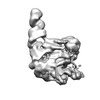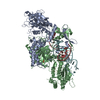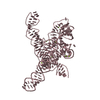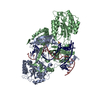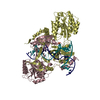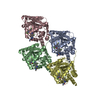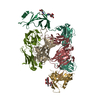+ Open data
Open data
- Basic information
Basic information
| Entry | Database: EMDB / ID: EMD-22258 | |||||||||
|---|---|---|---|---|---|---|---|---|---|---|
| Title | Cryo-EM structure of Cas12g ternary complex | |||||||||
 Map data Map data | unsharpened | |||||||||
 Sample Sample |
| |||||||||
 Keywords Keywords | CRISPR / HYDROLASE-RNA complex | |||||||||
| Biological species | metagenome (others) | |||||||||
| Method | single particle reconstruction / cryo EM / Resolution: 4.8 Å | |||||||||
 Authors Authors | Chang L / Li Z / Zhang H | |||||||||
 Citation Citation |  Journal: Nat Chem Biol / Year: 2021 Journal: Nat Chem Biol / Year: 2021Title: Cryo-EM structure of the RNA-guided ribonuclease Cas12g. Authors: Zhuang Li / Heng Zhang / Renjian Xiao / Ruijie Han / Leifu Chang /  Abstract: Cas12g, the type V-G CRISPR-Cas effector, is an RNA-guided ribonuclease that targets single-stranded RNA substrate. The CRISPR-Cas12g system offers a potential platform for transcriptome engineering ...Cas12g, the type V-G CRISPR-Cas effector, is an RNA-guided ribonuclease that targets single-stranded RNA substrate. The CRISPR-Cas12g system offers a potential platform for transcriptome engineering and diagnostic applications. We determined the structures of Cas12g-guide RNA complexes in the absence and presence of target RNA by cryo-EM to a resolution of 3.1 Å and 4.8 Å, respectively. Cas12g adopts a bilobed structure with miniature REC2 and Nuc domains, whereas the guide RNAs fold into a flipped 'F' shape, which is primarily recognized by the REC lobe. Target RNA and the CRISPR RNA (crRNA) guide form a duplex that inserts into the central cavity between the REC and NUC lobes, inducing conformational changes in both lobes to activate Cas12g. The structural insights would facilitate the development of Cas12g-based applications. | |||||||||
| History |
|
- Structure visualization
Structure visualization
| Movie |
 Movie viewer Movie viewer |
|---|---|
| Structure viewer | EM map:  SurfView SurfView Molmil Molmil Jmol/JSmol Jmol/JSmol |
| Supplemental images |
- Downloads & links
Downloads & links
-EMDB archive
| Map data |  emd_22258.map.gz emd_22258.map.gz | 18.8 MB |  EMDB map data format EMDB map data format | |
|---|---|---|---|---|
| Header (meta data) |  emd-22258-v30.xml emd-22258-v30.xml emd-22258.xml emd-22258.xml | 11.1 KB 11.1 KB | Display Display |  EMDB header EMDB header |
| Images |  emd_22258.png emd_22258.png | 57.2 KB | ||
| Filedesc metadata |  emd-22258.cif.gz emd-22258.cif.gz | 5.7 KB | ||
| Archive directory |  http://ftp.pdbj.org/pub/emdb/structures/EMD-22258 http://ftp.pdbj.org/pub/emdb/structures/EMD-22258 ftp://ftp.pdbj.org/pub/emdb/structures/EMD-22258 ftp://ftp.pdbj.org/pub/emdb/structures/EMD-22258 | HTTPS FTP |
-Validation report
| Summary document |  emd_22258_validation.pdf.gz emd_22258_validation.pdf.gz | 388.6 KB | Display |  EMDB validaton report EMDB validaton report |
|---|---|---|---|---|
| Full document |  emd_22258_full_validation.pdf.gz emd_22258_full_validation.pdf.gz | 388.2 KB | Display | |
| Data in XML |  emd_22258_validation.xml.gz emd_22258_validation.xml.gz | 5.6 KB | Display | |
| Data in CIF |  emd_22258_validation.cif.gz emd_22258_validation.cif.gz | 6.3 KB | Display | |
| Arichive directory |  https://ftp.pdbj.org/pub/emdb/validation_reports/EMD-22258 https://ftp.pdbj.org/pub/emdb/validation_reports/EMD-22258 ftp://ftp.pdbj.org/pub/emdb/validation_reports/EMD-22258 ftp://ftp.pdbj.org/pub/emdb/validation_reports/EMD-22258 | HTTPS FTP |
-Related structure data
| Related structure data |  6xmgMC  6xmfC C: citing same article ( M: atomic model generated by this map |
|---|---|
| Similar structure data |
- Links
Links
| EMDB pages |  EMDB (EBI/PDBe) / EMDB (EBI/PDBe) /  EMDataResource EMDataResource |
|---|
- Map
Map
| File |  Download / File: emd_22258.map.gz / Format: CCP4 / Size: 30.5 MB / Type: IMAGE STORED AS FLOATING POINT NUMBER (4 BYTES) Download / File: emd_22258.map.gz / Format: CCP4 / Size: 30.5 MB / Type: IMAGE STORED AS FLOATING POINT NUMBER (4 BYTES) | ||||||||||||||||||||||||||||||||||||||||||||||||||||||||||||||||||||
|---|---|---|---|---|---|---|---|---|---|---|---|---|---|---|---|---|---|---|---|---|---|---|---|---|---|---|---|---|---|---|---|---|---|---|---|---|---|---|---|---|---|---|---|---|---|---|---|---|---|---|---|---|---|---|---|---|---|---|---|---|---|---|---|---|---|---|---|---|---|
| Annotation | unsharpened | ||||||||||||||||||||||||||||||||||||||||||||||||||||||||||||||||||||
| Voxel size | X=Y=Z: 1.05 Å | ||||||||||||||||||||||||||||||||||||||||||||||||||||||||||||||||||||
| Density |
| ||||||||||||||||||||||||||||||||||||||||||||||||||||||||||||||||||||
| Symmetry | Space group: 1 | ||||||||||||||||||||||||||||||||||||||||||||||||||||||||||||||||||||
| Details | EMDB XML:
CCP4 map header:
| ||||||||||||||||||||||||||||||||||||||||||||||||||||||||||||||||||||
-Supplemental data
- Sample components
Sample components
-Entire : CRISP-Cas complex
| Entire | Name: CRISP-Cas complex |
|---|---|
| Components |
|
-Supramolecule #1: CRISP-Cas complex
| Supramolecule | Name: CRISP-Cas complex / type: complex / ID: 1 / Parent: 0 / Macromolecule list: #1-#3 |
|---|---|
| Source (natural) | Organism: metagenome (others) |
-Macromolecule #1: CRISPR-Cas
| Macromolecule | Name: CRISPR-Cas / type: protein_or_peptide / ID: 1 / Number of copies: 1 / Enantiomer: LEVO |
|---|---|
| Source (natural) | Organism: metagenome (others) |
| Molecular weight | Theoretical: 89.89168 KDa |
| Recombinant expression | Organism:  |
| Sequence | String: MAQASSTPAV SPRPRPRYRE ERTLVRKLLP RPGQSKQEFR ENVKKLRKAF LQFNADVSGV CQWAIQFRPR YGKPAEPTET FWKFFLEPE TSLPPNDSRS PEFRRLQAFE AAAGINGAAA LDDPAFTNEL RDSILAVASR PKTKEAQRLF SRLKDYQPAH R MILAKVAA ...String: MAQASSTPAV SPRPRPRYRE ERTLVRKLLP RPGQSKQEFR ENVKKLRKAF LQFNADVSGV CQWAIQFRPR YGKPAEPTET FWKFFLEPE TSLPPNDSRS PEFRRLQAFE AAAGINGAAA LDDPAFTNEL RDSILAVASR PKTKEAQRLF SRLKDYQPAH R MILAKVAA EWIESRYRRA HQNWERNYEE WKKEKQEWEQ NHPELTPEIR EAFNQIFQQL EVKEKRVRIC PAARLLQNKD NC QYAGKNK HSVLCNQFNE FKKNHLQGKA IKFFYKDAEK YLRCGLQSLK PNVQGPFRED WNKYLRYMNL KEETLRGKNG GRL PHCKNL GQECEFNPHT ALCKQYQQQL SSRPDLVQHD ELYRKWRREY WREPRKPVFR YPSVKRHSIA KIFGENYFQA DFKN SVVGL RLDSMPAGQY LEFAFAPWPR NYRPQPGETE ISSVHLHFVG TRPRIGFRFR VPHKRSRFDC TQEELDELRS RTFPR KAQD QKFLEAARKR LLETFPGNAE QELRLLAVDL GTDSARAAFF IGKTFQQAFP LKIVKIEKLY EQWPNQKQAG DRRDAS SKQ PRPGLSRDHV GRHLQKMRAQ ASEIAQKRQE LTGTPAPETT TDQAAKKATL QPFDLRGLTV HTARMIRDWA RLNARQI IQ LAEENQVDLI VLESLRGFRP PGYENLDQEK KRRVAFFAHG RIRRKVTEKA VERGMRVVTV PYLASSKVCA ECRKKQKD N KQWEKNKKRG LFKCEGCGSQ AQVDENAARV LGRVFWGEIE LPTAIP |
-Macromolecule #2: RNA (130-MER)
| Macromolecule | Name: RNA (130-MER) / type: rna / ID: 2 / Number of copies: 1 |
|---|---|
| Source (natural) | Organism: metagenome (others) |
| Molecular weight | Theoretical: 43.777043 KDa |
| Sequence | String: GGGAUGCUUA CUUAGUCAUC UGGUUGGCAA ACCUCCGCGG ACCUUCGGGA CCAAUGGAGA GGAACCCAGC CGAGAAGCAU CGAGCCGGU AAAUGUUUAC CGGCUCUGAC ACCAACUGUG AUAAACUACC GCAUUAA |
-Macromolecule #3: RNA (5'-R(P*UP*UP*AP*AP*UP*GP*CP*GP*GP*UP*AP*GP*UP*UP*UP*AP*UP*CP...
| Macromolecule | Name: RNA (5'-R(P*UP*UP*AP*AP*UP*GP*CP*GP*GP*UP*AP*GP*UP*UP*UP*AP*UP*CP*AP*CP*AP*GP*UP*U)-3') type: rna / ID: 3 / Number of copies: 1 |
|---|---|
| Source (natural) | Organism: metagenome (others) |
| Molecular weight | Theoretical: 7.633511 KDa |
| Sequence | String: UUAAUGCGGU AGUUUAUCAC AGUU |
-Macromolecule #4: ZINC ION
| Macromolecule | Name: ZINC ION / type: ligand / ID: 4 / Number of copies: 1 / Formula: ZN |
|---|---|
| Molecular weight | Theoretical: 65.409 Da |
-Experimental details
-Structure determination
| Method | cryo EM |
|---|---|
 Processing Processing | single particle reconstruction |
| Aggregation state | particle |
- Sample preparation
Sample preparation
| Buffer | pH: 7.5 |
|---|---|
| Grid | Details: unspecified |
| Vitrification | Cryogen name: ETHANE |
- Electron microscopy
Electron microscopy
| Microscope | FEI TITAN KRIOS |
|---|---|
| Image recording | Film or detector model: GATAN K3 (6k x 4k) / Average electron dose: 1.35 e/Å2 |
| Electron beam | Acceleration voltage: 300 kV / Electron source:  FIELD EMISSION GUN FIELD EMISSION GUN |
| Electron optics | Illumination mode: OTHER / Imaging mode: BRIGHT FIELD |
| Experimental equipment |  Model: Titan Krios / Image courtesy: FEI Company |
- Image processing
Image processing
| Startup model | Type of model: EMDB MAP |
|---|---|
| Final reconstruction | Applied symmetry - Point group: C1 (asymmetric) / Resolution.type: BY AUTHOR / Resolution: 4.8 Å / Resolution method: FSC 0.143 CUT-OFF / Number images used: 38238 |
| Initial angle assignment | Type: RANDOM ASSIGNMENT |
| Final angle assignment | Type: MAXIMUM LIKELIHOOD |
 Movie
Movie Controller
Controller



